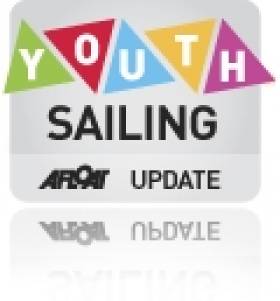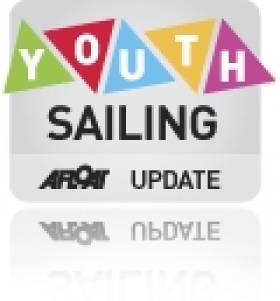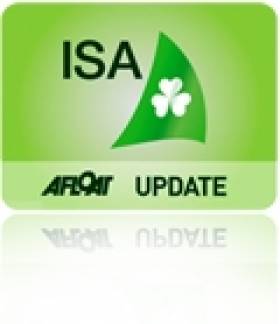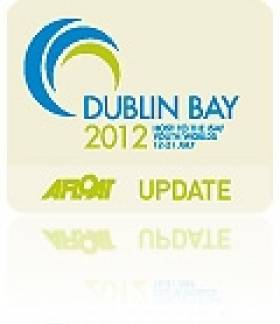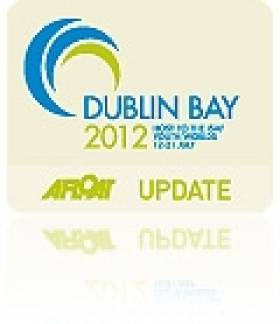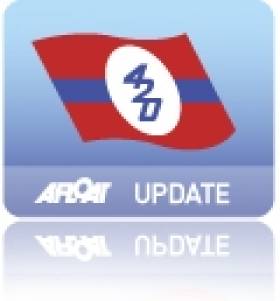Displaying items by tag: ISAF Youth Worlds
#youthsailing – New Irish youth sailing star Seafra Guilfoyle has extended his lead in the 53-boat Laser Radial class at the ISAF youth worlds in Tavira, Portugal this afternoon. The Royal Cork single-hander has a three–point cushion over Martin Lowy (BRA) and Denmark's Patrick Dieter following two days of competition.
It was a late start and a late finish on the second day of competition with the last competitors reaching the shore at 21:00 local time.
The breeze came in late in the day and the first start came at 16:01 local time before the final competitors reached the shore at 21:00.
A light yet consistent westerly breeze ensured all eight fleets completed a full complement of races on the Algarve to shape up the leader boards nicely.
The performance on the Algarve is yet another example of the Munster man's grit that has already seen that the current all–Ireland junior champion take 15th overall at a 158–boat Europa Cup event earlier this season and this month finish in sixth place from 155–starters at the European Laser Youth Championships in Denmark.
It was a day for Spain in the Laser Radial with three of four race wins going the way of Spanish racers.
Spain's Martina Reino was head and shoulders above the 46-boat girls fleet as she took double bullets whilst Joel Rodriguez took the fourth race bullet in the 57-boat boys division.
Reino moves up into second overall and was thrilled with her day, "I had very good starts and then the races were easy for me," smiled Reino.
"When you start the race very good you can go where you want and that's the easy part. In the first one I won by over a minute and in the second it was also by a big distance."
The opening bout for Rodriguez, 2014 Radial Youth European Champion, did not go to plan as he finished 12th but he bounced back and sits fifth overall. He explained his day, "In the first race I had a very bad start and was at the bottom of the fleet which made it difficult. I finished 12th and then in the second race I started good and with my speed I was able to win the race.
"It was a very close race with like five guys very close. The racing is at a very good level, very close and very difficult to win."
The Spaniards took a good haul of Nations Trophy points from the Laser Radial races and both sailors have an eye on the prize, "I think we can win the Nations Trophy but the other countries are very good and it's difficult to win but can do it," said Reino.
Rodriguez added, "I think the sailors come to win the individual regatta but if we can win the Nations Trophy then that would be great."
Haddon Hughes (USA) retained her lead in the Laser Radial Girls fleet with a discarded 18th and a second in race four. Italy's Valentina Balbi is third overall.
In the Laser Radial Boys Seafra Guilfoyle (IRL) holds on to top spot and is followed by and Denmark's Patrick Dopping (DEN).
And in a further boost for Irish youth sailing, it's not the only good news coming from decidedly mixed conditions in Portugal. In this afternoon's race three Sean Waddilove and Robert Dickson from Howth scored a fifth in the double–handed 420 class, their best result of the regatta so far.
Full results so far are here
SL16
2014 SL16 World Champions Louis Flament and Charles Dorange (FRA) took two out of three race victories to move into the lead in the 16-boat fleet.
From six races, the French duo have three bullets alongside a second, a third and a sixth to lead the fleet on eight points, seven ahead of Jordi and Ruben Booth (ESP).
After racing the pair said, "We had a good start and after that we controlled everything. We went fast and we won the races easily."
The competition is fast and fierce with little separation in the fleet and the pair know the challenges they face at the event, "The ISAF Youth Worlds is more difficult than the Open SL16 Worlds. The Spanish, New Zealand and finally the Brazilians are all very strong and are our main rivals," said Flament, "and Great Britain," joked Dorange with the British team in sight.
Flament and Dorange are revelling in their ISAF Youth Worlds experience with smiles aplenty amongst the youngsters. The pair concluded, "It's a special event because there's one representative from each nation and we're privileged to represent France. It's a pleasure and an honour to be in the French team and we are happy to represent our nation."
Overnight leaders Kim Vidal and Antonio Lopes (BRA) have dropped to third overall after finishing in the middle of the pack in their races.
Seven further races are scheduled over the remaining three days of competition with anything possible out on the race course.
RS:X
Whilst the 29ers were the first off the water, the RS:X fleets were last off, reaching the shore at 21:00 local time after completing three races in the RS:X Boys and Girls fleets.
Russia's Stefaniya Elfutina was the stand out performer in the RS:X Girls fleet taking double bullets and a fourth. She holds top spot on 11 points and is followed by China's Shi Hongmei and Italy's Marta Maggetti.
The top four RS:X Boys racers have cemented their positions in the leading spots with seven points splitting them. Overnight leader Yael Paz (ISR) tops the bills on 11 points and is followed by Mattia Camboni (ITA) on 14 and Radoslaw Furmanski (POL) on 17 points.
Competition in the RS:X Boys is close knit with the day's race wins going the way of Paz, Camboni and Spain's Antonio Bonet.
420
Japan's Ibuki Koizumi and Kotaro Matsuo and Malaysia's Mohammad Faizal Norizan and Ahmad Syukri Abdul Aziz picked up the day's 420 Boys race victories and have a strong hold on the top two spots.
Koizumi and Matsuo lead on four points and are followed by the Malaysian pair who have eight points.
In the first race of the day Faizal and Syukri read the conditions perfectly and lead from the off as Syukri explained, "We had a good start in the first one and at the starting line we crossed all of the fleet from the pin end. The Italians followed us and they finished behind us in second at the end.
"We will try to keep in the top five for the rest of the event."
Faizal and Syukri have been racing in the 420 for two year's having competed against each other in the Optimists. The pair had a string of success in Optimists and have transferred their skills expertly to the 420. With Japan in their sights and five more races to go anything can happen.
France's Hippolyte Machetti and Sidoine Dantes trail the Malaysians by seven points in third overall.
In the 27-boat 420 Girls fleet Theres Dahnke and Birte Winkel (GER) picked up a pair of second place finishes and move into pole position.
The Germans overthrew day one leaders Silvia Mas and Marta Davila (ESP) but only have a slender two point lead.
2013 silver medallists Nadja Horwitz and Carmina Malsh (CHI) are third overall.
29er
France's Brice Yriex and Loic Fischer Guillou (FRA) took top spot in the 30-boat 29er fleet after a second day of consistent racing on Tavira's waters. The French duo recorded a 1-4-1 scoreline and take the lead away from Hong Kong's Yann Thierry D'Argrenlieu and Nathan Bradley who drop to third.
Quinn Wilson and Riley Gibbs (USA) moved up to second overall.
Racing resumes on 13:00 local time on Wednesday 16 July.
Irish Youth Sailors Trying to Find Form in Cyprus
#isafyouthworlds – Flying the flag for Ireland at the ISAF Youth Worlds in Limassol, Cyprus, an eight crew Irish team are among the world's best youth sailors drawn from 61 nations.
Racing in marginal planing conditions in yesterday's day two, Ireland is still hoping to make a break-through but so far no Irish crew are in the top third of any fleet, with two more days racing to come.
With racing all on schedule it is as per Addendum C of the Sailing Instructions today with three races scheduled at 12:00 for the 29er, RS:X Boys, RS:X Girls and SL16.
Two races are scheduled for 12:00 in the Laser Radial Boys and 420 Boys with three races on the cards for the Laser Radial Girls and 420 Girls at 15:00.
At the moment a 5-8 knot south westerly breeze is blowing with 30 degrees of heat and humidity at 70-80%.
As the day moves forward 12:00 will see a 8-12 knot breeze with 16 knot gusts before 10-14 knots comes in the early afternoon with 18 knot gusts.
In the Laser Radial, Robbie Gilmore (Strangford Lough Yacht Club) lies 24th from 56 after the first five races, and in the Girls division Sarah Eames (Ballyholme Yacht Club) is 25th from 40.
The team of five boys and three girls will compete in a massive fleet of 351 sailors across three different classes, sailing 2-3 races per day until the final race on Friday.
In the 420 dinghy, Robert Dickson and Sean Waddilove (Howth Yacht Club) are 16th from 31 after five and in the Girls 420
Cliodhna Ni Shuilleabhain (Kinsale Yacht Club) and Jill McGinley (Royal Cork Yacht Club) are 19 from 27.
In the 29er Skiff, Sean and Tadgh Donnelly (National Yacht Club), racing in their second youth worlds event, lie 26th from 28.
Last year, Ireland's Finn Lynch won silver on Dublin Bay when the Royal St. George and National Yacht Club's hosted the event. It was Ireland's best ever performance and the first medal since 1996.
Athlete Participation Programme Now Open For 2013 Youth Worlds
#YouthSailing - The International Sailing Federation (ISAF) is now inviting applications to its Athlete Participation Programme for the 2013 ISAF Youth Sailing World Championship in Limassol this summer.
The ISAF Athlete Participation Programme (APP) was created in 2002 and assists athletes with attending the ISAF Youth Sailing World Championship by offering coaching support and financial subsidies towards the entry fee and travel costs. The World Youth Sailing Trust also provides a championship coach.
The APP is targeted at sailors from nations in subscription categories 1 and 2. Priority will be given to new countries and for countries that have not participated in the ISAF Youth Worlds in the last two years.
Thanks to APP funding, sailors from the Cook Islands, Cuba, El Salvador, Serbia, Botswana and Paraguay have been able to compete at the ISAF Youth Sailing World Championship.
The APP allows athletes, via their member national authority, to apply for support in the following three ways:
Event Coaching and Support: Athletes who are not able to travel with a team leader or coach are able to apply for coaching support. The on-site Championship coach will be available for pre and post race briefings and other essential event support.
Entry Fee Subsidy: Athletes may apply for a subsidy towards the event entry fee.
Travel Subsidy: Athletes may apply for a subsidy towards their travel expenses in order to attend the Championship.
All ISAF member national authorities have been sent the ISAF APP Application Form. The form must be returned to the ISAF Secretariat by 5pm on 25 February 2013.
The 2013 ISAF Youth Sailing World Championship will take place in Limassol, Cyprus from 13-20 July 2013. The event is open to competitors aged under 19 in the year of the championship (ie for Ireland, under 19 on 31 December 2013) in the events and equipment listed here:
- Boy's One Person Dinghy - To be confirmed
- Girl's One Person Dinghy - To be confirmed
- Boy's Two Person Dinghy - 420
- Girl's Two Person Dinghy - 420
- Boy's Windsurfer - RS:X with 8.5m2 sail
- Girl's Windsurfer - RS:X with 8.5m2 sail
- Open Multihull - Sirena SL16
- Open Skiff - 29er
Simply getting to the championship is a major achievement for most as entry is limited to one boat per nation, per event, meaning sailors first having to win through their national qualification series.
Entry details have been sent to all ISAF MNAs who are reminded that the deadline for submitting the Boat Reservation Form is 31 January 2013.
ISA Chief Sees Bright Future for Irish Sailing
#IRISH SAILING - Irish Sailing Association (ISA) chief executive Harry Hermon took time out from the ISAF annual conference in Dublin this week to talk to Sport for Business about the growth of sailing in Ireland.
“2012 has been in many ways a breakthrough year for the sport,” he said. “We hosted so many major events during the year, from the Volvo Ocean Race finale in Galway to the World Youth Championships on Dublin Bay and of course it was an Olympic year and we had our strongest performance for many years.”
Aside from building on commercial partnerships, Annalise Murphy's near-medal-winning performance at the London Olympics was a boon for the profile of sailing in the public's imagination, and Hermon intends for the ISA to capitalise on this in the years to come, both for the Rio Games in 2016 and beyond.
“20,000 young people are coming through certified courses each year and staying with the sport," he said. "In addition we are reaching out to tens of thousands more through multi-activity camps ‘on the water’ around the coastal and inland waterways that are such an attribute in Ireland.
“We have a sport that enables 18-year-olds to race alongside their grandparents and few can offer such a crossover appeal.”
Sport for Business has much more on the story HERE.
#isafyw12 – In the midst of all the excitement and hullabaloo of the ISAF Youth Worlds a large group of club members are giving up their time to ensure that competing boats are launched and recovered rapidly and without undue stress.
The Royal St George YC has offered all the volunteers an opportunity to get out on the water to view the racing. As part of this initiative, with the express wish that the event leaves as wide a legacy as possible, the forecourt team have set up a "rules coaching" initiative.
Every day the keenest young racing sailors go out on the water in a RIB with an experienced ISA National Judge/Umpire. The future champions are introduced to the particular way in which the judges view the racing. Whilst most sailors might admire how a 420 tacked, how the crew moved rapidly out to a full trapezing position... the judge would be pointing out that the boat, from the moment she passed head to wind until she was on a close-hauled course, was subject to rule 13 "Whilst Tacking" and, having tacked from port to starboard, she had acquired right of way and was obliged to give an approaching port tack boat room to keep clear...
This is also an opportunity for young sailors to learn something of the mechanics of running a serious regatta. Realising that marks are being laid as the competitors sail round the course, listening in on the race committee's discussion as they decide and implement a change of course, in reaction to a change in the wind direction... or shadowing the judges as they view the start line, checking for rule 42 infringements (the young sailors having first read the official ISAF interpretations of the rule regulating methods of propulsion) enriches their understanding of how the race officals work.
By the end of the Championship 45 of Ireland's keenest young sailors, not only from the Royal St George but also groups from Lough Derg and Galway Bay, will have benefited from this experience.
For further information on this initiative contact Gordon Davies 086150122
#isafyw12 – Hopes of landing Ireland's first Youth Sailing World Championship medal since 1996 were kept very much alive today by National YC Dun Laoghaire's Finn Lynch when the young Laser Radial helm responded perfectly to the requests of his experienced coach and delivered an eighth and fourth on the penultimate day's racing at the 2012 Four Star Pizza ISAF Youth World Sailing Championship on Dublin Bay.
Whilst many of his key rivals in the 58 boat Laser Radial Boys fleet struggled for such consistency across another two challenging races in moderate 8-13kts breezes, Lynch elevated himself to third place overall with just one final race scheduled tomorrow (Friday).
First and second steps on the podium are very much out of reach for the 16 year old helm who is racing at his first Youth Sailing World Championship and he faces a tough showdown with the Norwegian Hermann Tomasgaard who is only one point behind. While Lynch has risen to the occasion, sailing a mature regatta considering his years, Tomaasgard is the reigning Laser Radial Youth World Champion and was one of the favourites to lift this ISAF Youth Sailing World title.
"Those results were pretty good by comparison." Smiled Lynch, " I was trying to risk a bit more again today so that I can get up there, and that seemed to work. I think I was smart enough in my risks though. I was in 15th in the first race and caught up to seventh which was good."
" Then in the second race I went all out for the pin end of the start line and won it and so I felt good from there."
Lynch is certain he has felt no home advantage: " I really have not felt that comfortable at all, not in any of the races just because it has been so unpredictable. I had some luck today. "
" It is so unpredictable I can go out there and get a 40th tomorrow, so I will just concentrate on the same things and try and get a result."
" It has been a great event. I have not felt so on top of the weather because it has been so changeable, but it feels really good now today. Now there is so much support for me it is really nice and it all helps. I feel like I have a bit of momentum going into tomorrow. There has been no extra pressure and I feel like I have peaked at the right time, peaking towards the end of the regatta."
In the Laser Radial Girls class Ireland's Sophie Murphy remains in 14th place after a mixed day on the water. After concentrating on her school studies this winter and spring she has raced fewer regattas than many of her rivals, but nonetheless has remained solid in the top third of the fleet.
The young Cork 420 duo of Patrick Crosbie and Grattan Roberts lie 15th after finishing their penultimate day with a seventh, though a bad start in the earlier race left them struggling to a 21st.
"We were dead on the start line, left behind with no speed which was not good. But the second race was so much better." Said Roberts.
With one race left scheduled to be sailed two titles have already been decided. First ashore to the Royal St George YC slipway were the young Barcelona duo of Carlos Robles and Florian Trittel who successfully defended the 29er skiff class title that they won last year in Croatia.
And in the SL16 catamaran class GBR's Rupert White and Tom Britz, current overall world champions in the class, secured the gold medal with a flourish, winning both races today to set up an unassailable lead.
White, grandson of 1976 Oympic Tornado gold medallist Reg White, won bronze in this class last year in Croatia with a different crew.
ISAF Youth Worlds 2012
Day FIVE results (& overall points)
Laser Radial (Boys)
1st - Mitchell Kiss (USA) 95pts 2nd – Mark Spearman (AUS) 108pts 3rd – Finn Lynch (IRE) 125pts
Laser Radial (Girls)
1st – Julia Carlsson (SWE) 55pts 2nd – Line Flem Host (NOR) 74pts 3rd- Cecilia Zorzi (ITA) 88pts
420 (Boys)
1st – Guillaume Pirouelle/Valentin Sipan (FRA) 49pts 2nd - Pieter Goedhart/Lars Van Stekelenborg (NED) 59pts 3rd - David Charles/Alex Charles (ESP) 62pts
420 (Girls)
1st – Ilaria Paternoster/Benedetta Disalle (ITA) 40pts 2nd – Carrie Smith/Ella Clark (AUS) 41pts 3rd- Annabel Vose/Kirstie Urwin (GBR) 51pts
29ers
1st - Carlos Robles/Florian Trittel (ESP) 20pts 2nd – Lucal Rual/Thomas Biton (FRA) 28pts 3rd – Klaus Lange/Mateo Majdalani (ARG) 34pts
SL16 Catamaran
1st –Rupert White/Tom Britz (GBR) 18pts 2nd – Martin Manzoil Lowy/Kim Vidal (BRA) 35pts 3rd - Paul Darmanin/Lucy Copeland (AUS) 37pts
RSX Boys
1st – Wonwood Cho (KOR) 29pts 2nd- Matta Camboni ( ITA) 29pts 3rd – Maxime Labat (FRA) 58pts
RSX Girls
1st - Saskia Sills (GBR) 28pts 2nd – Naomi Cohen (ISR) 41pts 3rd – Veronica Fanciulli (ITA) 53pts
Irish Team Standings after DAY FIVE
Radial Boys
Finn Lynch – 3rd (125pts)
Radial Girls
Sophie Murphy – 14th (144pts)
420 Boys
Patrick Crosbie/Grattan Roberts – 15th (141pts)
SL16 Boys
Alexander Rumball/Rory McStay - 9th (90pts)
29er Boys
Sean Donnelly/Tadgh Donnelly – 11th (113pts)
Tomorrow’s Olympians in Dun Laoghaire for ISAF Youth Worlds
#ISAF YOUTH WORLDS - Four years of hard graft by the Dublin Bay 2012 organisers comes to a head tomorrow with the start of the Four Star Pizza Youth Worlds, the 42nd ISAF Youth Sailing World Championships.
Dun Laoghaire welcomes 350 sailors aged 14-19 years of age from 63 nations, plus their coaches and team leaders, for the annual highlight of the youth sailing calendar, known as the Youth Olympics of sailing, which begins tomorrow Saturday 14 July running till 21 July.
After a highly competitive bidding process, organisers in Dublin were honoured that Ireland was chosen to host this much celebrated event, which is renowned for providing the world with its first glimpse of future sailing stars and Olympians.
“We have been waiting four years for this, so it is really exciting,” says Brian Craig, chairman of the Dublin Bay 2012 organising committee. “Everyone is buzzed up - there is great enthusiasm among the sailors. It’s great. For us it is a chance of a lifetime to run an event like this.”
A five-boat Irish team will join the sailors competing in a total of eight classes, including the Laser Radial singlehander, the 420 doublehander, the RS:X windsurfer, the 29er skiff and the SL 16 multihull.
These classes are directly relevant to the Olympic Games, the 420 being the small version of the Olympic 470, the 29er being the same equivalent to the 49er and so on. This is no coincidence, as Craig explains.
“This is the pathway to the Olympics, so to get an event like that here in Ireland is superb for us. It is bringing all the top sailors here. For all our youth sailors around the country, they are going to see all these role models.”
In fact, some of the world’s top sailors are former Youth Worlds winners. Stu Bannatyne, recently arrived into Galway as a watch leader on CAMPER in the Volvo Ocean Race, won in 1989, while his skipper Dean Barker won in 1990.
Others include Tessa Parkinson, who won the 420 girls’ title in 2004 with Elise Rechichi before both graduated up to the 470, winning Olympic gold for Australia at Beijing 2008. Parkinson is in Dun Laoghaire as a coach for the Australian team.
“There is a high correlation between people that win medals at the Youth Worlds who then go on and win Olympic medals,” she says “It definitely is a big platform. In Australia if you get a good result at youth level, you can get a position in the development squad for the Australian Sailing Team and it is a way to progress up through the Olympic classes.”
Parkinson has fond memories of Ireland as here she sailed her first ever international regatta in 2001. “This is a great venue for the Youth Worlds. The courses are so close to the club and everyone has been so friendly.”
An impressive aspect of the ISAF Youth Worlds is the number of sailors from overseas taking part, with 63 nations being represented in Dun Laoghaire - including some first timers such as Oman.
Moreovr, 25 sailors have been subsidised to be here by the ISAF’s Athlete Participation Programme. Among the nations supported are Chile, Guatemala, Paraguay, Puerto Rico, Serbia and Ukraine.
Racing sets sail tomorrow for all eight classes, with two races scheduled for the start at 12pm.
The Royal St George Yacht Club, the National Yacht Club and the Royal Irish Yacht Club in Dun Laoghaire have been appointed to host the championship in association the Irish Sailing Association (ISA), and the weekend kicks off with a public celebration to complement the first races in the championship.
For further information visit www.isafyouthworlds.com and www.dublinbay2012.com.
#isaf – Ireland's Sophie Murphy and Norway's Hermann Tomasgaard will look to use their experience to win gold at the 2012 Four Star Pizza ISAF Youth Sailing World Championship in Dublin, Ireland.
At just 18-year's old Murphy will not only bring her knowledge of her home waters to the regatta, but her big event experience, that cannot be rivalled. Murphy first sailed at the ISAF Youth Worlds in 2010 before heading to the inaugural Singapore 2010 Youth Olympic Games.
The following year she sailed at the 2011 ISAF Youth Worlds in Zadar, Croatia followed by the World Laser Radial Youth Championship in La Rochelle, France. With none of the top ten from Zadar competing in Dublin, Murphy is the highest placed finisher from 2011 coming into the regatta. With her 11th place finish and experience behind her, added to knowledge of Dublin Bay a podium finish will be on the cards.
"Sailing has been my favourite sport and the memories and friends I have made are the best part of the sport," said Murphy. "Every time you sail the circumstances change. It's so exhilarating.
"To sail for Ireland is really the ultimate privilege for me. I want to thank all those people who have made it possible, namely my family, my coach Milan, the ISA, my team and all the friends with whom I love sailing."
Newcomer to the Youth Worlds, Maxime Jonker (NED), recently won the Laser Radial Youth Worlds in Queensland, Australia. Jonker came up against several competitors who will be in Dublin and set an early marker by taking the title.
Returnees from previous ISAF Youth Worlds include Maria Cristina Boabaid (BRA), Celine Carlsen (DEN), Milda Eidukeviciute (LTU), Natalia Montemayor (MEX), Khairunneeta Mohd Afendy (MAS), Stephanie Devaux-Lovell (LCA) and Julia Carlsson (SWE).
The Laser Radial Boys fleet has the makings of an excellent competition after eight competitors finished in the top ten at the Laser Radial Youth Worlds in Queensland.
Herman Tomasgaard (NOR) came out on top in Australia on a count back from New Zealand's Andrew McKenzie, both finished on 24 points. Tomasgaard's victory has no doubt set the standard for the rest of the 59-boat fleet to follow and with two ISAF Youth Worlds behind him, a fifth at Istanbul 2010 and ninth at Zadar 2011, the Norwegian will be the one to beat.
McKenzie will compete in his first ISAF Youth Worlds in Dublin but knows what it takes to compete at the front of the fleet after he picked up silver in Australia.
America's Mitchell Kiss rounded off the podium in Queensland and will return to the ISAF Youth Worlds following his 16th place finish in Zadar. "I feel like I am in a good place going into ISAF Youth Worlds," he explained. "Eight out of the top 10 finishers at this regatta will also be in Dublin. I learned about my competitors' strengths and weaknesses this week. I feel well prepared, and am hoping for a little more breeze.
"I expect the competition will be very tough and there will be more distractions - like the press and the hype," he said. "I am glad I had the chance to learn that last year. This is going to be my last international youth event so I am going to really go for it."
Returning from Zadar 2011 in the Laser Radial Boys fleet will be Juan Ignacio Biava (ARG), Owen Siese (BER), Mihkel Väli (EST), Charalampos Mavrogeorgis (GRE), Domonkos Rozsnyay (HUN), Dominykas Kneizys (LTU), Wouter Sonnema (NED), Eduardo Marques (POR) and Pavlo Babych (UKR).
Racing at the 2012 Four Star Pizza ISAF Youth Sailing World Championship begins on 14 July in Dun, Laoghaire, Co. Dublin, Ireland running until 20 July.
#dublinbay2012 – There will be host nation debuts in both the SL16 catamaran and 29er skiff classes at the 2012 Four Star Pizza ISAF Youth Worlds on Dublin Bay in ten days time.
Sean Donnelly and Tadgh Donnelly compete in the 29er and Alexander Rumball and Rory McStay go in the SL16 but as the championships is also set to welcome back 2011 gold medallists in both the SL16 and 29er the Irish crews have their work cut out.
Martin Lowy and Kim Andrade (BRA) head to Dublin to defend the SL16 title they comprehensively won in Zadar, Croatia last year whilst Spain's Carlos Robles and Florian Trittel (ESP) will be aiming to do the double.
The 15 strong SL16 fleet has the makings of an excellent competition with five of the six medallists at the 2011 ISAF Youth Worlds back again.
Lowy and Andrade blew the competition away in the light winds in Croatia that were prevalent at the start of the competition winning eight races in a row to set them up for the gold medal. When the big conditions came in the Brazilians finished mid-fleet as Danish twin brothers Nicolaj and Daniel Bjornholt Christiansen kicked it up a gear with four top two finishes.
The Danes comeback only proved enough for the silver medal as the Brazilians won by a seemingly comfortable margin of seven points.
The conditions in Ireland may suit the Bjornholt Christiansen's whose size will prove advantageous. Great Britain's Rupert White finished third with Nikola Boniface in 2011, he returns with Tom Britz.
In four years' time the Mixed Multihull will be on show at the Rio 2016 Olympic Sailing Competition following the selection of the Nacra 17. The Open SL16 event at this year's regatta features several mixed crews. Paul Darmanin and Lucy Copeland (AUS) are one of those in Dublin with Rio 2016 on their mind, "The mixed multihull for the Games is on our rader but I just want to focus on the Youth Worlds at the moment," said Darmanin who won SL16 gold in 2010 as crew with Chase Lurati.
"My cousin Jason and sister Lisa are training very hard working towards the 2016 Games so for me to try for the Olympics I would have to battle it out against them.
"Competing at the Olympic Games would be the ultimate dream come true as it is the highest level of sailing around. I love representing Australia so doing it at the Olympics would be fantastic."
New Zealand's Tomer Simhony finished fifth at the 2011 ISAF Youth Worlds in the SL16 with Ellie Copeland and is back again with another female crew, Gemma Jones. And the pair have considered their futures, "I think they [ISAF] made the right choice with the Nacra 17," said Simhony. "Gemma and I have discussed sailing together and will at least try to get a boat in the next two years and start a campaign. We'll see how it goes."
Twenty six teams will compete for 29er gold but the undermining favourites coming into the event are the 2011 Champions Carlos Robles and Florian Trittel (ESP). The Spaniards stormed to gold in Zadar, Croatia with a string of consistent results over 12 races to claim gold by 18 points.
With only Klaus Lange and Mateo Majdalani (ARG) returning from the top ten finishers in 2011, the Spaniards will aim for a second successive gold. Other returnees from 2011 include Paul Kohlhoff and Carolina Werner (GER), Varun Thakkar and Ganapathy Kelapanda (IND), as well as Alex Burger and Alex Lehtinen (RSA).
The fleet features a new wave of young sailors who will be seen beyond 2012 with 43 of the 52 sailors competing in the 26-boat fleet eligible to sail at the 2013 edition in Limassol, Cyprus. Belgium's Emile Van Holsbeke will be the youngest competitor in the 29er fleet at just 14-years-old. He will crew alongside Daan Vandormael.
Racing at the 2012 Four Star Pizza ISAF Youth Sailing World Championship begins on 14 July in Dun, Laoghaire, Ireland running until 20 July.
#420– Royal Cork Yacht Club sailors Patrick Crosbie and Grattan Roberts who will sail for Ireland in the Four Star Pizza ISAF Youth Worlds in July won the 420 dinghy Connacht Championships hosted on May 7th by Galway Bay Sailing Club.
A superb weekend's racing was had by the small but competitive 11-boat fleet. Conditions varied from light and variable on Sunday morning increasing to a moderate southerly later. Strong rain squalls made for exhilarating conditions on the Monday where crews and boats were well tested.
Second overall were Royal St George pairing Adam Hyland and Bill Staunton while the Malahide duo of Lizzy McDowell and Orlagh Thompson took third.
The 420 Munster Championship originally scheduled for RCYC in June has been rescheduled to a weekend in September – the new date will be confirmed shortly.



























